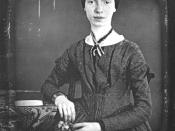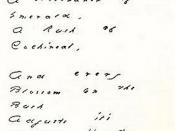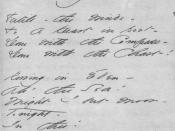The Cycle of Life
For as long as history has been recorded, man has always been at odds at with the thought of his own death. Even the few who have accepted death amiably have at some point feared, dreaded, or attempted to postpone its arrival. We have personified death as someone evil who appears unpredictably, only to take you unwillingly from this world to the next. But in reality, we know that death is not the uncontrollable grim reaper that we find in fairy tales and movies. Rather than being malicious and unjust, death is an inevitable part of the cycle of life. In recent centuries, poets have spent much of their time writing of death and its inescapability-both as something to be admired as well as feared. In her haunting poem entitled, "Because I Could Not Stop For Death," Emily Dickinson realizes that to escape death is unachievable, and she shows that it need not be painful, therefore the poem sustains a serene tone throughout.
Death is personified by Dickinson as being compassionate, and kind- making it feel more acceptable. Through
Dickinson's precise style of writing, effective use of literary elements, and vivid imagery, she creates a poem that can be interpreted in many different ways.
As human beings, it is in our nature to feel that death does not come in a convenient or opportune time. When Dickinson says, "Because I could not stop for Death," she causes the reader to begin wondering why she could not stop. The apparent response is that she was so wrapped up in the chaos of life, she was too busy to think
Golriz 2
about death. She makes death's inescapability clear in the next line though when she says, "He kindly stopped for me." In this last line...



Duplicate Submission
Thank you for a good analysis of Emily Dickenson's popular poem. For someone who lived a relatively sheltered life, Ms. Dickenson had remarkable insights and "Because I could not stop for Death" is a poem which has universal appeal. Your report is highly readable and engaging. Other than for the fact that death was capitalized in the title of your prior essay on the same topic, this appears to be the same report as the one you submitted three days earlier. Commendable!
7 out of 7 people found this comment useful.